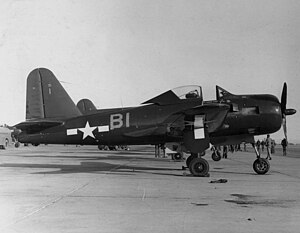Ryan FR Fireball
| FR-1 Fireball | |
|---|---|
 |
|
| An FR-1 Fireball of VF-66 at NAS North Island, 1945 | |
| Role | Fighter |
| Manufacturer | Ryan Aeronautical |
| First flight | 25 June 1944 |
| Introduction | March 1945 |
| Retired | 1 August 1947 |
| Primary user | United States Navy |
| Produced | 1944–1945 |
| Number built | 71 |
| Variants | XF2R Dark Shark |
|
|
The Ryan FR Fireball was a mixed-power (piston and jet-powered) fighter aircraft designed by Ryan Aeronautical for the United States Navy during World War II. It was the Navy's first aircraft with a jet engine. Only 66 aircraft were built before Japan surrendered in August 1945. The FR-1 Fireball equipped a single squadron before the end of the war, but did not see combat. The aircraft ultimately proved to lack the structural strength required for operations aboard aircraft carriers and was withdrawn in mid-1947.
Design of the FR-1 began in 1943 to a proposal instigated by Admiral John S. McCain, Sr. for a mixed-powered fighter because early jet engines had sluggish acceleration that was considered unsafe and unsuitable for carrier operations. Ryan received a contract for three XFR-1 prototypes and one static test airframe on 11 February 1943 with the first two prototypes delivered in 14 months. Another contract was placed for 100 aircraft on 2 December 1943 and a later contract on 31 January 1945 increased the total of FR-1s on order to 700.
The XFR-1 was a single-seat, low-wing monoplane with tricycle landing gear. A 1,350-horsepower (1,010 kW) Wright R-1820-72W Cyclone radial engine was mounted in the fighter's nose while a 1,600 lbf (7,100 N) General Electric I-16 (later redesignated as the J-31) turbojet was mounted in the rear fuselage. It was fed by ducts in each wing root which meant that the wing had to be relatively thick to house the ducts and the outward-retracting main landing gear. To simplify the fuel system, both engines used the same grade of avgas. Two self-sealing fuel tanks were housed in the fuselage, one of 130 US gallons (490 l; 110 imp gal) and the other of 50 US gallons (190 l; 42 imp gal). The cockpit was positioned just forward of the leading edge of the wing and the pilot was provided with a bubble canopy which gave him excellent visibility. The XFR-1 had the first laminar flow airfoil in a navy carrier aircraft.
...
Wikipedia
